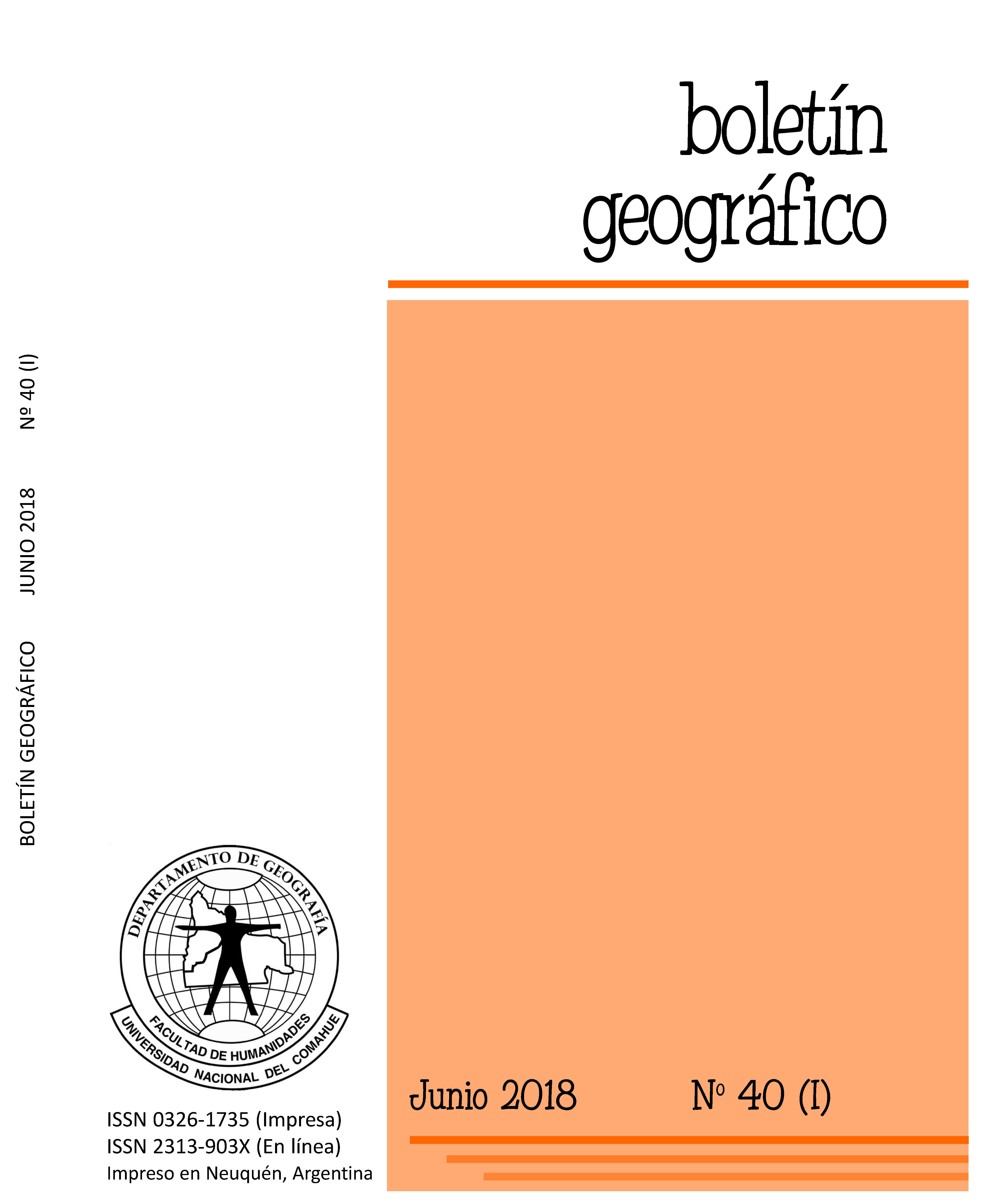A GEOGRAPHICAL INTEGRAL APPROACH OF PROTECTED AREAS. THE CASE OF LA PAMPA
Keywords:
Protected areas, multiscalarity, multitemporalityAbstract
Protected areas are spaces to be preserved, so they should be studied as a system from an integral vision. Components of natural and socio-cultural environment are geographically analyzed in an interrelated way to understand the system and to provide solutions to issues that occur in these places. The study includes transversal concepts to the analysis variables: multiscalarity and multitemporality. The aim of the paper is to propose the study of protected areas from an integral vision under a geographical perspective. This is why the explanation of the theoretical approach propose the selection and analysis of variables for the study of protected areas. Scientific articles made on protected areas in La Pampa Province were analyzed and proved that this approach is currently not considered. A case study was presented in which strengths and weaknesses of a holistic approach were analyzed.
Downloads
References
Azuela Bernal, L. F., Delgado Campos, J. Y. & Fernández Christlieb, F. (2000). La geografía como ciencia integradora; dieciocho siglos de "interdisciplina". I Encuentro. La experiencia interdisciplinaria en la Universidad, Universidad
Nacional Autónoma de México.
Barzetti, V. (Ed.). (1993). Parques y progreso. Áreas protegidas y desarrollo económico en América Latina y el Caribe. Gland: UICN. 246 pp.
Cabrera, A.L. (1976). Regiones fitogeográficas argentinas. Buenos Aires. Acme. 85 pp. En: Kugler WF (Ed) Enciclopedia argentina de agricultura y jardinería. Tomo 2. Fascículo 1. pp. 1-85.2o edición. Acme. Buenos Aires.
Campo, A. M. (2015). Geografía Física: ¿tradicional o aplicada?. En: A. M. Campo, V. Gil, J. O. Gentili, P. A. Zapperi, A. Volonté, M. B. Ramos, B. Andalur y M.P. Torrero, Geografía Física Aplicada (pp.11-25). Bahía Blanca: EdiUNS.
Carton de Grammont, P., Bocco, G., Córdova, A. & Winklerprins, A. (2011). La conservación de la biodiversidad. Un campo de integración para la Geografía. Interciencia: Revista de ciencia y tecnología de América, 36(8), 630-636.
Casas Grande, J. (1999). Conservación y espacios protegidos: el papel de los agentes locales. En: M. Corbera (Ed.), Cambios en los espacios rurales cantábricos tras la integración de España en la UE (pp. 251-296). Madrid: Universidad de Cantabria.
Cuadra, D. E. (2014). Los enfoques de la geografía en su evolución como ciencia. Revista Geográfica Digital, 21, 1-22.
Duval, V. (2017). Estudio integral de áreas protegidas: Reserva Provincial Parque Luro y Parque Nacional Lihué Calel, provincia de La Pampa (Tesis doctoral). Universidad Nacional del Sur, Bahía Blanca.
Duval, V., Benedetti, G. & Campo, A. C. (2017). Situación actual de las áreas protegidas en la provincia de La Pampa, Argentina. Revista Geográfica Venezolana, 58(1), 164-181.
Estébanez, J. (1982). Tendencias y problemática actual de la Geografía. Madrid: Cincel S.A. 144 pp.
Fenneman, N. (1919). The Circumference of Geography. Geographical Review, 7(3), 168. doi: 10.2307/207825
Garayo Urruela, J. M. (1996). Concepción integrada de la conservación de la naturaleza y categorías de espacios naturales protegidos. Lurralde: Investigaciones Espaciales 19, 215-234.
García Rol, J. & Domené Sánchez, D. (1996). Geografía de España. Madrid: Ediciones Laberinto. 191 pp.
Herrera Rodríguez, M. (2010). La geografía como disciplina integral: notas teóricas y empíricas. Investigación y desarrollo, 18(2), 390-415.
http://repositoriodigital.uns.edu.ar/bitstream/123456789/4131/1/TESIS%20DOCTO RAL_DUVAL_2017.pdf http://www2.fct.unesp.br/nera/revistas/14/6_santoja.pdf (20 de noviembre de 2017)
https://www.sib.gov.ar/2017/#!/areas-protegidas
https://www.unioviedo.es/reunido/index.php/RCG/article/view/1611/1526
Maurín Álvarez, M. (2008). Las áreas protegidas: un enfoque geográfico. Ería, Revista de Geografía, 76, 165- 195.
Moore, A. (Ed.). (1993). Manual para la capacitación del personal de áreas protegidas. Washington: National Park Service. 162 pp.
Sack, R. D. (2003). A Geographical Guide to the Real and the Good. New York: Routledge. 302 pp.
Santonja, J. (2009). Hacia una Geografía útil: el papel de la Geografía en el siglo XXI en España. Revista NERA, 12(14), 7-27.
Published
How to Cite
Issue
Section
License
Copyright (c) 2018 Boletin GeográficoTransfer of rights and data processing
The acceptance of an article for publication in the Journal Geographic Bulletin implies the cession of the rights of printing and reproduction, by any means and means, of the author in favor of the Department of Geography of the National University of Comahue, which will not reject any request reasonable for the authors to obtain permission to reproduce their contributions. The total or partial reproduction of the works published in the Geographic Bulletin must be done citing the origin, otherwise, the copyright is violated.
Likewise, it is understood that the concepts and opinions expressed in each work are the sole responsibility of the author, without being responsible or in solidarity, necessarily, neither the editorial staff nor the editorial staff.
It is the responsibility of the authors to be able to provide interested readers with copies of the raw data, procedure manuals, scores and, in general, relevant experimental material.
Likewise, the Management of the journal guarantees the appropriate treatment of personal data
COPYRIGHT TRANSFER FORM


















 Journal of the
Journal of the 